Example Signals
This page provides some examples of the appearance of signal masts, and the signal aspects displayed by them, on different lines and in different circumstances. For an explanation of the various terms used here, and how signals are used in Japanese railroading, see my Japanese Signals page.
Station Entrance and Exit Signals
Below, left, is an example of the signals where a two-track station becomes a single-track line. The Kanji on the number plate means “go out” or “come out” (among other things), so it can probably be read as “this signal applies to trains going out on track #1”. The white diamond on the lower part of the signal appears to contain two red lights arranged vertically.
The right photo, on the same line, is a “repeating signal” at an entrance to a station, and has the same lower signal, but with different markings. According to wikipedia, the diagonal means caution, and it is likely repeating the yellow-over-yellow signal at the platform entrance. Note the orange post to the right of the signal; this is a flashing “obstruction” signal, to warn the operator of something blocking the tracks ahead. This is likely triggered by someone falling off the platform, as that is one use for such signals according to wikipedia.
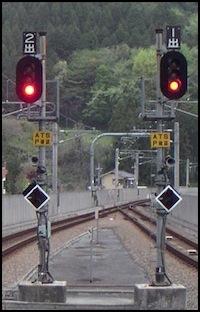
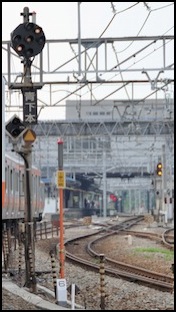
Station Exit (left, 2006) and Entrance (right, 2009) signals
JR East Itsukaichi Line, Musashi-Itsukaichi and Haijima Stations
Photographers: っ, and ykanazawa1999
Below left is an example of a station exit signal. This one is at the JR West Tsurugaoka station in Osaka. On the left is the signal for track 3 as a train has just passed it, going out of the station. In the center the next, the signal on that track shows clear (green). Track 4, to the left, connects to track 3, and the signal is red, probably because the switch is set for track 3 to use it. Note the simplicity of these signals, with just the yellow triangle (meaning unknown, but it is used by JR to designate a signal as something I haven’t been able to figure out based on the google translation: a 信 号喚呼位, or Position Signal, it may mean “block signal”, except that there’s a different Japanese phrase for those, 閉塞信号機 heisoku shingōki) and the track number in addition to the signal head. The right photo shows a more distant signal (likely a block signal) further out on the same line that tracks 3 & 4 connect to. It appears to be a three-color signal with the yellow triangle, but no other markings. This is taken from the same photo as the one above it, and is the signal the blue train is approaching.

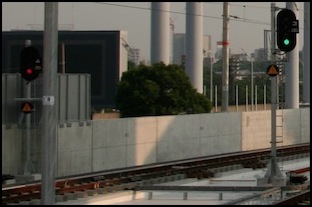
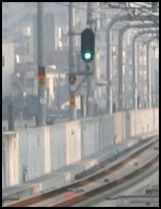
Three signals at Tsurugaoka (2006)
JR West
Photographer (all): zeraien
The next photo shows a typical signal used where two routes can be accessed from one track. Although this can be shown in a variety of ways (including lit signs with the name of the track the signal is presently indicating, or subordinate lights showing the direction of motion to the track being signaled), this form is fairly common at stations where space for signals is limited and only two possible routes exist. The upper-left signal head indicates the status of the track to the left, and the lower-right head indicates the status of the track to the right.

Signals for two routes (2008)
Nankai Railway
Photographer: Ignis
Shinkansen use cab signals, which eliminates most needs for track-side signals. However, they do have signals in stations. I think the signal below shows a call-on signal above a shunting signal. Call on signals are used to allow trains to enter a section of track that already has one train. These are used in stations where two trains need to share a platform. Shunting signals are used for switching movements, but these are interlocked and cannot allow two trains to occupy the same track.
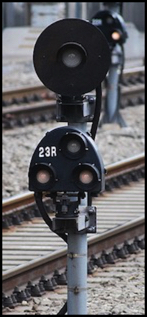
Tohoku Shinkansen signal (lower signal is a Shunting signal). Tōkyō Station (2013)
Photographer: Toshinori baba
Platform Signal
Below is an example of a station platform signal (actually two of them, back to back, plus a separate yellow signal of some kind). It appears to have a warning buzzer incorporated in the signal (gray disk on the right of the back signal, perforations on the left of the front signal).
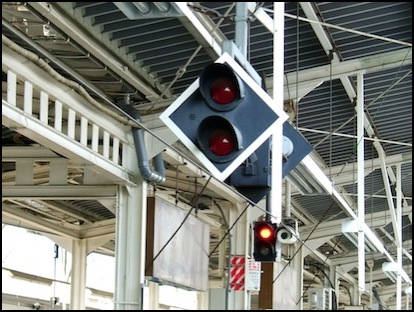
Signals at Tsuchiura Station, Ibaraki (2006)
JR East Jōban Line
From Flickr, Photographer: LHOON
Repeater Signal
A repeater signal is a position signals the displays the same information as an upcoming signal, used where visibility is limited (see another example up above).
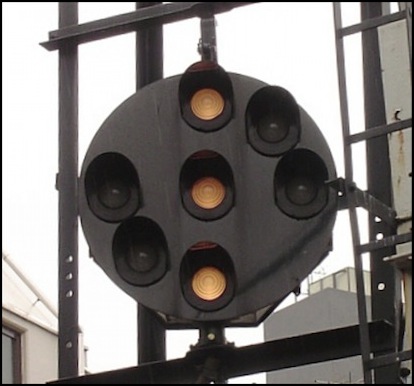
Repeater Signal showing “Proceed” (2006)
Odakyu Electric Railway, Yoyogihachiman Station
Photographer: PON2600
A “distant” signal
In the picture below, the distant signal is distinguished by the square shape of the head, as compared with the rounded heads on the home (yellow-over-yellow) and starting (red) signals.
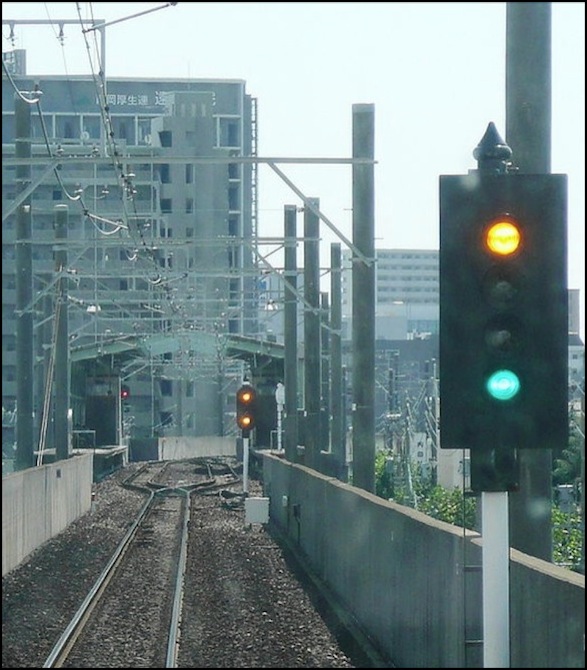
Home (center) and distant (right) signals at Hachiman station (2008)
Location: between Hachiman and Sukenobu stations on the Enshū Railway Line
Photographer: PekePON




